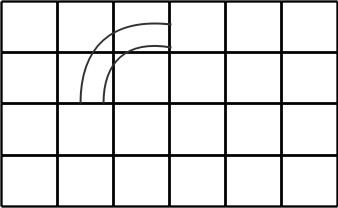Answer
64.8k+ views
Hint: We know that electric field, an electric property associated with each point in space when charge is present in any form. The magnitude and direction of the electric field are expressed by the value of E, called electric field strength or electric field intensity or simply the electric field. The electric field Intensity at a point is the force experienced by a unit positive charge placed at that point. Electric Field Intensity is a vector quantity. Electric field is not negative. It is a vector and thus has negative and positive directions. An electron being negatively charged experiences a force against the direction of the field. For a positive charge, the force is along the field. Based on this concept we have to solve this question.
Complete step-by step answer:
Radius = R
It is known to us that the measure of electrical charge per unit area of a surface or per unit volume of a body or medium is known as charge density.
As we can say that the charge density = $+\lambda$
$k=\dfrac{1}{4\pi {{\in }_{0}}}$
Now we can say that the electric field is defined as the electric force per unit charge. The direction of the field is taken to be the direction of the force it would exert on a positive test charge. The electric field is radially outward from a positive charge and radially in toward a negative point charge.
Electric field at the origin,
$=q=R\lambda$
$k=9\times {{10}^{9}}$or in this case just a constant.
$E=k{{R}^{2}}\int \,dqr$
On the evaluation we get that:
$=\dfrac{k\lambda }{R}$
$=\dfrac{\sqrt{2}k\lambda }{r}$
Hence, the correct answer is Option B.
Note: It should be known to us electric fields are an important tool in understanding how electricity begins and continues to flow. The electric fields of single charges. A negative charge has an inward electric field because it attracts positive charges. The positive charge has an outward electric field, pushing away like charges. But there cannot be a charge where there is no electric field. The existence of an electric field at a point where there is no charge just means that there is a charge relatively close by. But the field is a product of the charge, so without the charge there is no field.
It should be known that the electric field of an infinite line charge with a uniform linear charge density can be obtained by using Gauss' law. Considering a Gaussian surface in the form of a cylinder at radius r, the electric field has the same magnitude at every point of the cylinder and is directed outward.
Complete step-by step answer:
Radius = R
It is known to us that the measure of electrical charge per unit area of a surface or per unit volume of a body or medium is known as charge density.
As we can say that the charge density = $+\lambda$
$k=\dfrac{1}{4\pi {{\in }_{0}}}$
Now we can say that the electric field is defined as the electric force per unit charge. The direction of the field is taken to be the direction of the force it would exert on a positive test charge. The electric field is radially outward from a positive charge and radially in toward a negative point charge.
Electric field at the origin,
$=q=R\lambda$
$k=9\times {{10}^{9}}$or in this case just a constant.
$E=k{{R}^{2}}\int \,dqr$
On the evaluation we get that:
$=\dfrac{k\lambda }{R}$
$=\dfrac{\sqrt{2}k\lambda }{r}$
Hence, the correct answer is Option B.
Note: It should be known to us electric fields are an important tool in understanding how electricity begins and continues to flow. The electric fields of single charges. A negative charge has an inward electric field because it attracts positive charges. The positive charge has an outward electric field, pushing away like charges. But there cannot be a charge where there is no electric field. The existence of an electric field at a point where there is no charge just means that there is a charge relatively close by. But the field is a product of the charge, so without the charge there is no field.
It should be known that the electric field of an infinite line charge with a uniform linear charge density can be obtained by using Gauss' law. Considering a Gaussian surface in the form of a cylinder at radius r, the electric field has the same magnitude at every point of the cylinder and is directed outward.
Recently Updated Pages
Write a composition in approximately 450 500 words class 10 english JEE_Main

Arrange the sentences P Q R between S1 and S5 such class 10 english JEE_Main

What is the common property of the oxides CONO and class 10 chemistry JEE_Main

What happens when dilute hydrochloric acid is added class 10 chemistry JEE_Main

If four points A63B 35C4 2 and Dx3x are given in such class 10 maths JEE_Main

The area of square inscribed in a circle of diameter class 10 maths JEE_Main

Other Pages
A boat takes 2 hours to go 8 km and come back to a class 11 physics JEE_Main

Electric field due to uniformly charged sphere class 12 physics JEE_Main

In the ground state an element has 13 electrons in class 11 chemistry JEE_Main

According to classical free electron theory A There class 11 physics JEE_Main

Differentiate between homogeneous and heterogeneous class 12 chemistry JEE_Main

Excluding stoppages the speed of a bus is 54 kmph and class 11 maths JEE_Main




